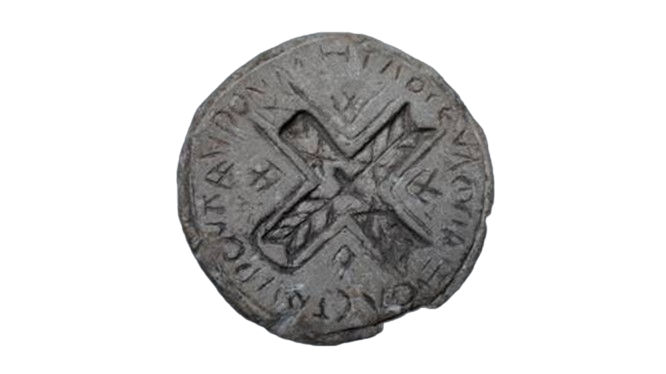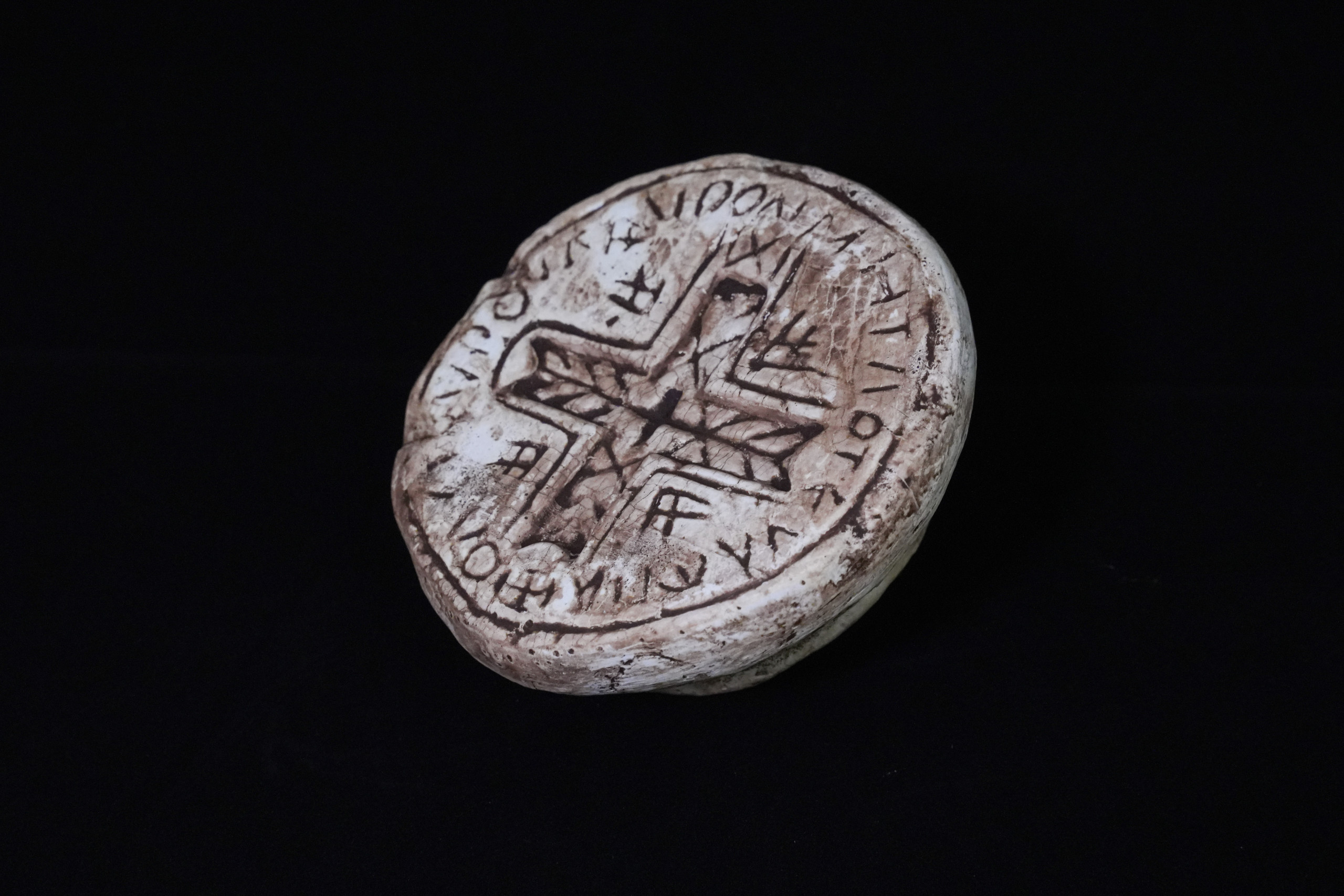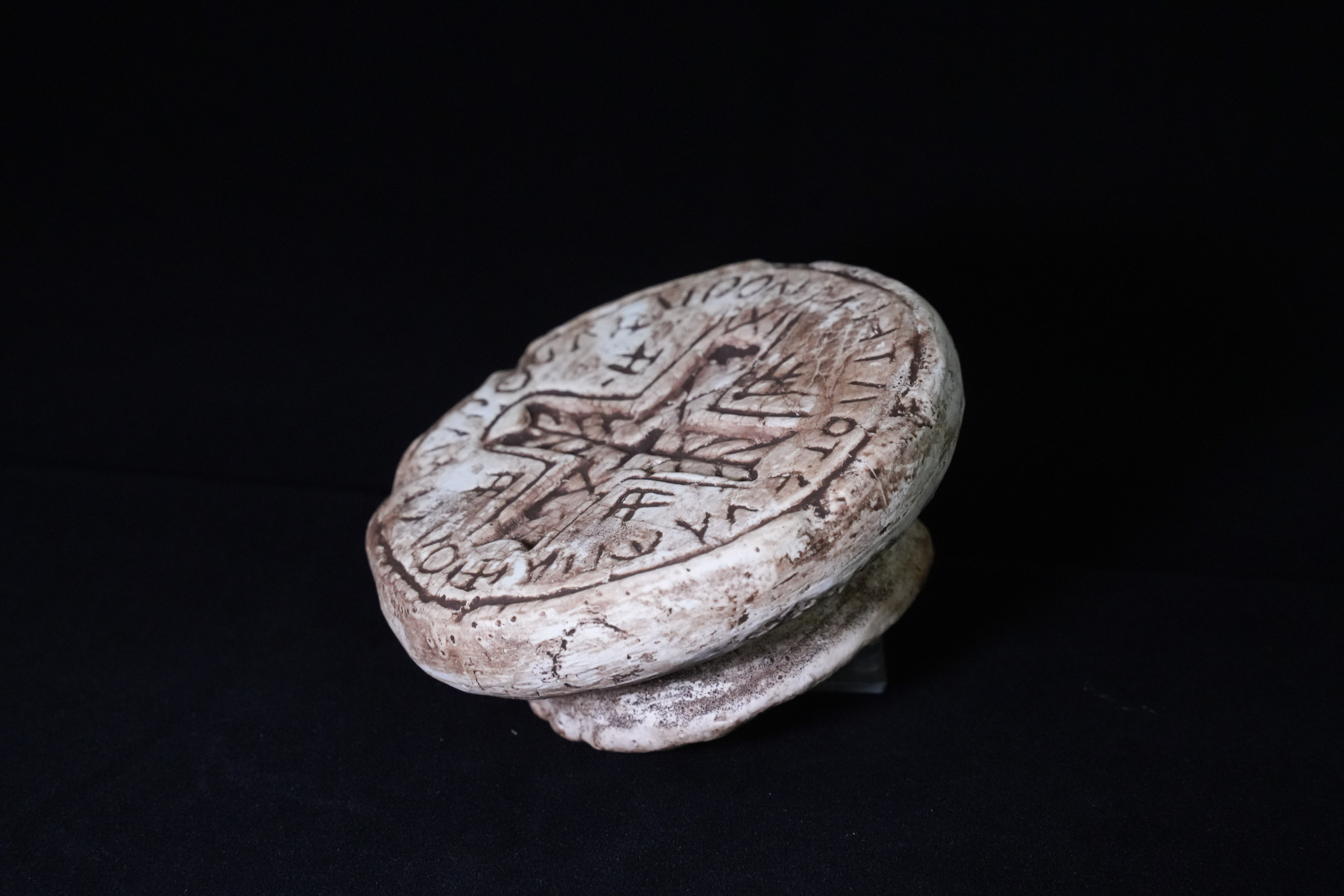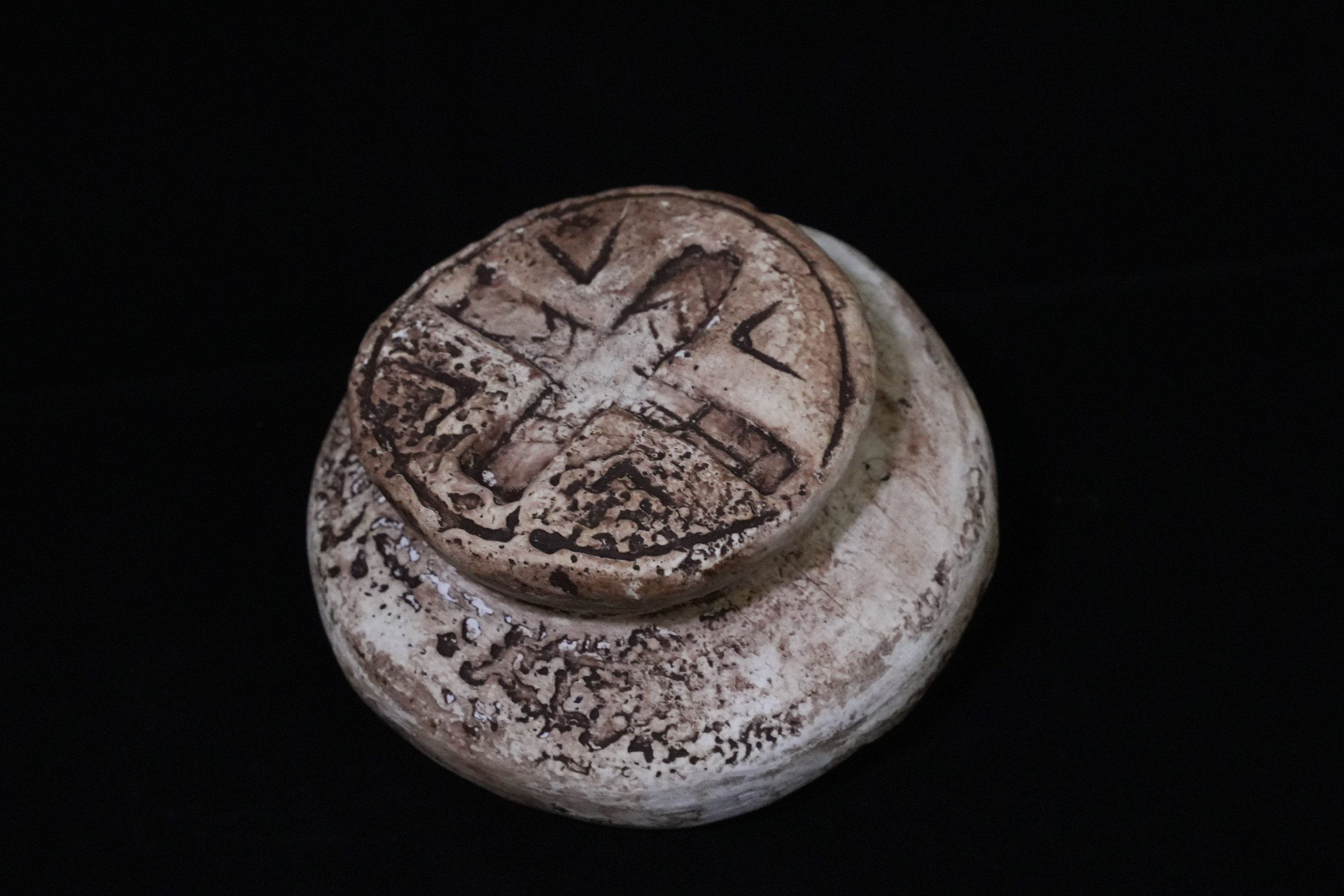1. Introduction
The artefact chosen for this case study is speculated to had been used for sealing bread or lead objects which were given as a blessing and/or memorial gift to the faithful during their visit to a particular pilgrimage. The artefact belongs to the George and Nefeli Giabra Pierides Museum of the Bank of Cyprus Cultural Foundation. The inscription of the seal/stamp of blessing shows a cross on its centre. The stamp probably dates from the c.6th century AD, thus placing it chronologically in the Early Medieval Byzantine period (or Early Christian period which dates from 395 to mid 7th century A.D., as defined by the Republic of Cyprus’ Department of Antiquities). The circular seal’s diameter is about 10 cm. The seal’s three antennae have a scissor tip, while the fourth one is straight. In the four corners there is an equal number of crosses. The central cross is decorated with geometric, cruciform and cruciform motifs. The seal is made of limestone, and it resembles works of stone or metal replicating them in design. The handle of the seal is also decorated with a cross. Currently there is no information on the seal’s provenance. The above information was given to the Mnemosyne project team by the head Curator of the Bank of Cyprus Cultural Foundation, Dr Christodoulos Hadjichristodoulou.
Currently the use of the specific stamp as a blessed object for marking bread is disputed by the Foundation’s Curator, Dr Hadjichristodoulou on the grounds that its inscription does not seem appropriate enough to stamp bread loaves. Based on relevant archeological evidence on other similar stamps, and in particular the metal blessing of Saint Mamas (Mammes, Mammas, Mammet) of Caesarea, the Curator speculates that seals of this type could had also been used for the manufacturing of blessing stamps, however without ruling out the sealing of bread as well. Dr Hadjichristodoulou notes that other objects were also given to the faithful as blessings, such as prayer beads or even the gesture of the priest who blessed the faithful during liturgy or in depictions in art, e.g. the Christ blessing with the right hand, etc. On the other hand, Dr. Ioanna Koltsida-Makri, an archaeologist whose research focuses on byzantine sigillography, supports that the stamp is most probably a bread stamp. Dr. Koltsida-Makri deciphered the stamp’s circular inscription as follows: “Blessings of Konstantinos, Paulus, Dommitius”, the inscription is written in mixed Greek and Latin letters. Koltsida-Makri hypothesizes that the bread seal probably belonged to a charitable organization and used to seal bread and other products for distribution. As our research for this case-study is still under development, both theories are given here, with the intention to arrive to more concrete findings as the research progresses. Thus, both theories are still under development and further evidence is expected to be revealed.
The specific artefact was chosen exactly because it has great significance as an object in the Bank of Cyprus Cultural Foundations collection. It is one of only three similar stamps found in Cyprus – the rest are kept at the Castle of Limassol -, and is the only one on display and in good condition. Its intangible value for the cultural heritage of Cyprus, and specifically as an artefact used for Christian worship, is unquestionable, because of the symbolism of stamped/blessed bread bear in eastern Christianity. Thus, the story of this bread is being told through these stamps, contributing in this way to our knowledge of the Early Christian eucharistic rites in general and of the Byzantine liturgy in particular. In Galavaris own words, “what I saw were no longer stamps but an image, however incomplete, of the bread used in the rites of the Orthodox Church”. Thus, this case-study also contributes in enriching our knowledge in the field of the symbolic sealing of an object or material (whether this is bread or a lead object or something else) for the ritual of the Christian worship.
On May 31, 2022, members of the Mnemosyne project team visited the Museum of George and Nefeli Giabra Pierides Collection, at the Bank of Cyprus Cultural Foundation, in Nicosia, in order to study and digitize artefacts belonging to the collection. The collection numbers more than 600 objects and covers a wide range of Cypriot Archaeology from the Early Bronze Age to the Medieval period. It includes unique examples of Mycenaean pottery and examples of pottery from the Geometric, Archaic, Classical, Roman and Medieval periods, clay figurines, stone sculptures and seals, jewellery, coins and bronze objects. In consultation with the Head Curator of the Museum, Dr Christodoulos Hatzichristodoulou, 8 objects were selected for study and digitization: 3 goat-shaped rytas of the Hellenistic period made of clay, 3 limestone statuettes of a clothed youth sitting of the Cypriot-classical period, a late-geometric Euboean skyphos and a seal with a cross in the centre dating from the c.6th AD. In collaboration with the University of West Attica, the study of the chemical composition of the objects was carried out through the non-invasive technologies of X-ray fluorescence spectroscopy and X-ray Raman spectroscopy, which allow the identification of traces of colours in the objects under study.
Furthermore, literature review is currently underway and, up until this point, there seems to exist a relative scarcity of secondary sources. Scholars explain that the literature is mute about bread stamps, these humble, unglamorous objects which are mostly forgotten in museum cases or catalogues, and in fact raise more questions than they answer. Bread stamps, wooden molds for eucharistic wafer, and other objects of similar use, are placed within the framework of Christian worship. Investigation on these objects is by default multi-disciplinary, allowing the researcher to cross from one discipline to many others, including archaeology, theology, church history, folklore, literature and baking methods. Bread, as a basic daily food, had a symbolic role in civilization since antiquity, especially as a symbol of peace and health, and as such was offered as a gift to the gods. Before the advent of Christianity, stamping the loaves of uncooked bread before baking, was an ancient practice based on religious and social grounds, such as offering bread printed with animal images to Asclepius thus wishing for good health. When the bread began to be printed with the use of Christian symbols, such as the Cross, the stamps which sometimes functioned as objects for protection, also acquired a Christian character, hence the word eulogia which in the Greek language means “blessing”, hence “blessing seals/stamps”. Eulogiai (plural for eulogia), in this case blessed objects, we mean objects or materials that, when in contact with something sacred they acquire a spiritual power, whose beneficial effect is passed on to the owners of these objects, in this case the stamped bread loaf.
Furthermore, Galavari mentions Leontius of Cyprus (d. ca. 650 AD) who spoke of eulogia sent from one person to another as a sign of affection, a use that recalls the ancient custom of sending blessed bread to others as a sign of communion. Eulogia bread was used effectively against evil, and in fact, this meaning of eulogia bread has persisted until today. Similar stamps to the one used for this case-study, many of which can be found for example at the Benaki Museum in Athens and at the Loulis Museum in Keratsini, Pireaus (Greece), seem to have been intended for the eucharistic bread, suggesting that they were used for a loaf of bread which was to carry a blessing. The loaf could have been distributed at the end of the liturgy, or taken home, or sent from one person to another as a sign of affection. For instance,
an example of a seven-century Byzantine text writes: “As soon as [the monks] ate and had their fill, they gave their friend three warm loaves of eulogia, they too were blessed, and one of the monks said: ‘give them to the holy man and tell him that they come from me. For the sake of God, pray for your brother John'”. Hence, here we see another use of the stamp, as an object which bears the identifiable mark of its owner, namely, the unique inscription which reveals its owner. These stamps, scholars argue, must had been in demand – given the information we so far have on their use. Issues of wide circulation and what this meant in terms of ideas and liturgical practices in particular localities of eastern Christianity still exist and are open to interpretation.
Our research has shown so far that medieval Christian pilgrims often travelled months or years to religious sites in the Holy Land and returned home with blessed mementos of their journey, such as vials of holy water, relics from saints, and even special loaves of bread or stamped objects. Molds were used to mark bread, for example with an image of the Church of Holy Sepulchre in Jerusalem and then the bread was distributed to pilgrims. It seems to had been common in early Christian practice to stamp images and inscriptions into loaves of bread and other objects, using special molds. Molds were probably used to stamp objects given to pilgrims visiting Jerusalem in commemoration of their journey (Mold for a Eulogia Blessing Bread, Clevelandart.org). Even though the secondary literature available so far on bread stamps, does not prove that the pilgrims carried a blessed stamp back to their distant countries to remind them of their pilgrimage, however, there is no doubt that such bread existed and was given to pilgrims, and that stamps were available. For a more precise definition of any stamp’s use, and in this case of our stamp, and as far as this is possible, we must rely more on their inscription. An early reading of the circular inscription of our seal has been given by Dr Koltsida-Makri, as mentioned above and, further research is ongoing.
Even though information on the stamp’s former use, provenance, and general “genealogy” is missing, its uniqueness as an artefact in the Bank of Cyprus Cultural Foundation’s is certain. At the request of the stakeholder, the Bank of Cyprus Cultural Foundation, which collaborates with the ERA Chair Mnemosyne on a regular basis, also on other Mnemosyne project case-studies , a high-quality digital twin of the blessing seal was reproduced. The purpose of this commission was to use the 3D replicas of the object as gifts to the Bank of Cyprus Cultural Foundation’s selected clientele. It was the first time in Cyprus, that within a short amount of time (i.e. 6 months), the digital documentation of an artefact was used to reproduce its identical 3D replica, in order to reuse it, in this case as a gift. Thus, with the assistance of a high-resolution photographic camera the object was photographed from several angles. The pre-processing of the photographs followed. With the assistance of specialised software the processed photographs were used to create the digital 3D geometry (digital twin) of the object (LOD5). The digital 3D geometry was then used to collect the necessary data for the 3D reconstruction of the object, using additive manufacturing processes (3D printing). For the 2022 Christmas period, the Blessing Seal has been reproduced as a copy to be given away to the Bank of Cyprus’ selected clientele. Within the research agenda of our project, further work in collaboration with our multidisciplinary experts and organisations, on the identity of the blessing seal is underway and findings are expected to shed more light on the so far unknown history of the artefact.
3. Estimation of Complexity & Quality
The following radial charts are base on the based on the EU 3D Study/VIGIE 2020/654
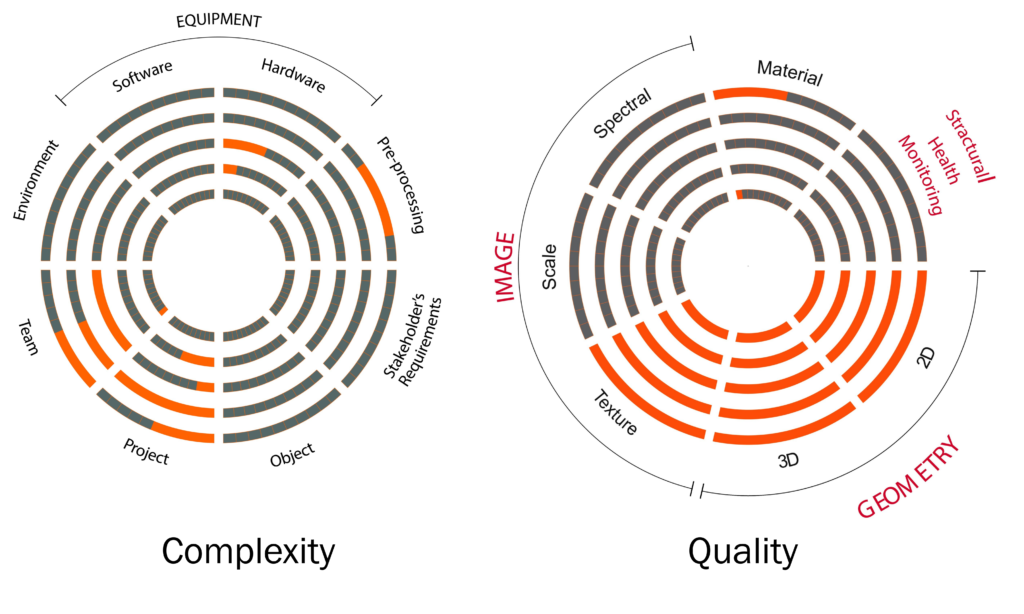
6. Research Output
Data Acquisition
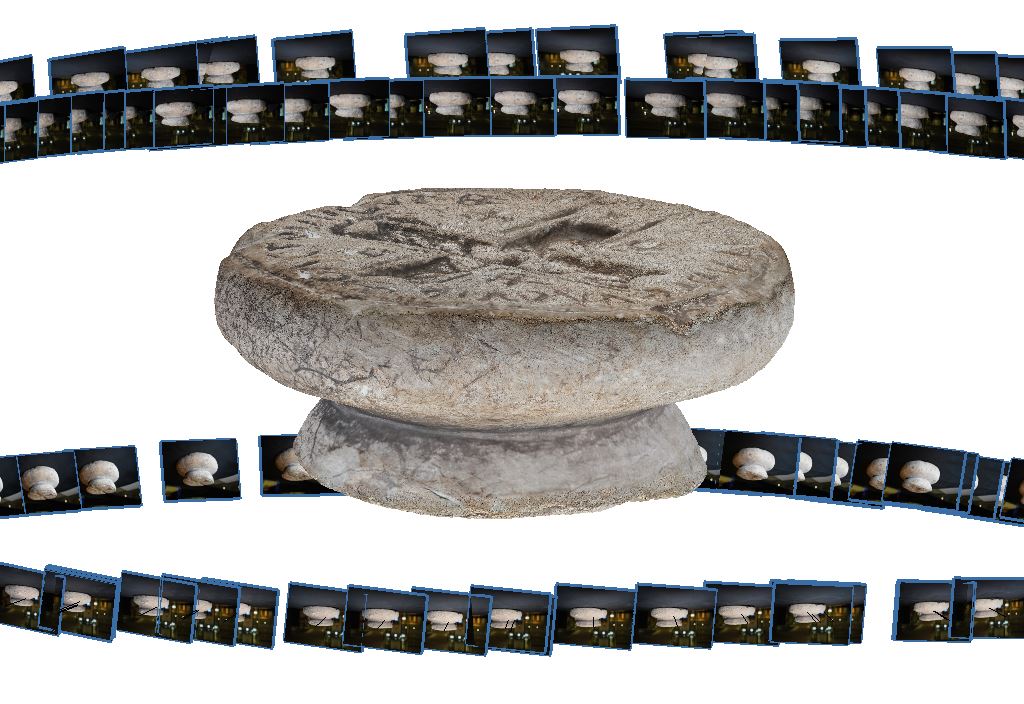



3D Fabrication
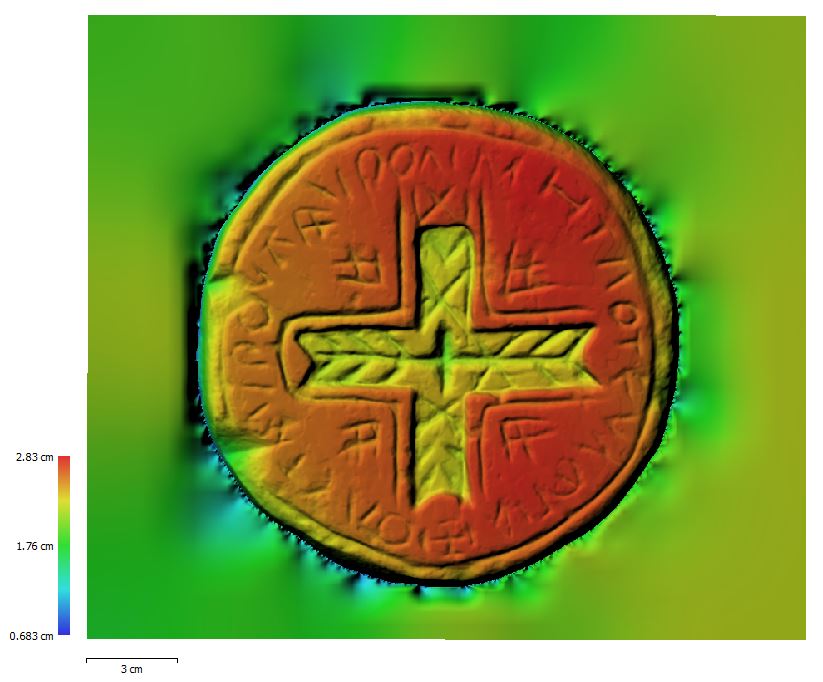
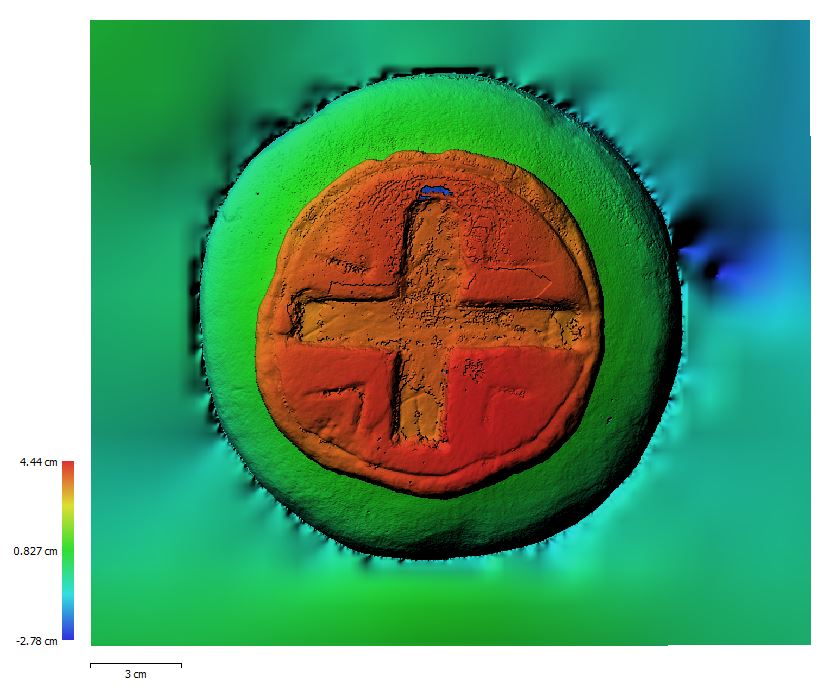


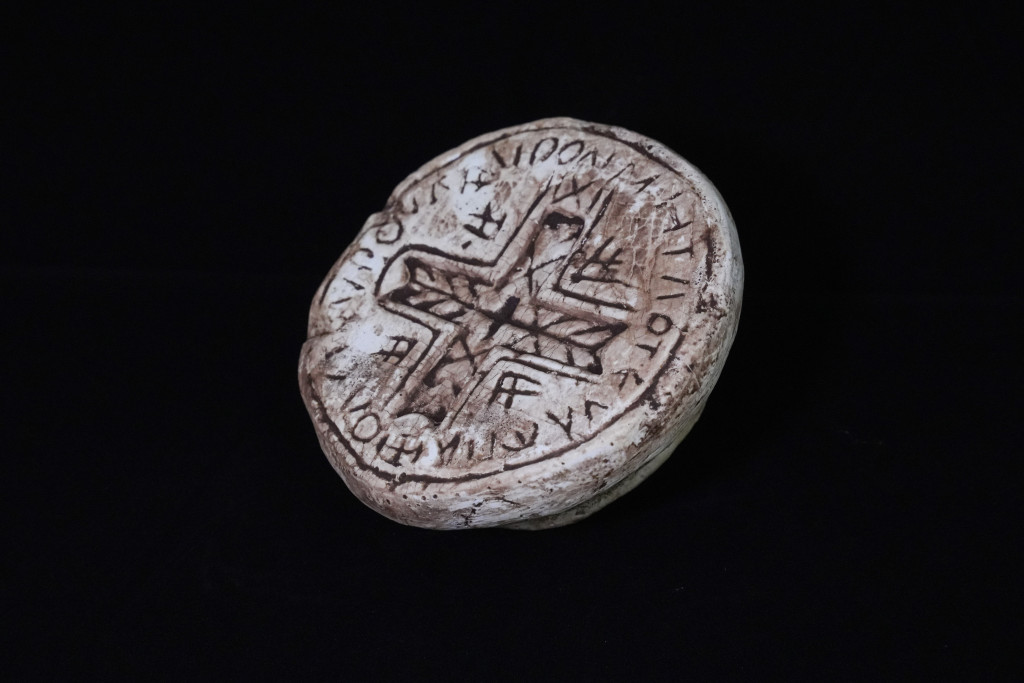
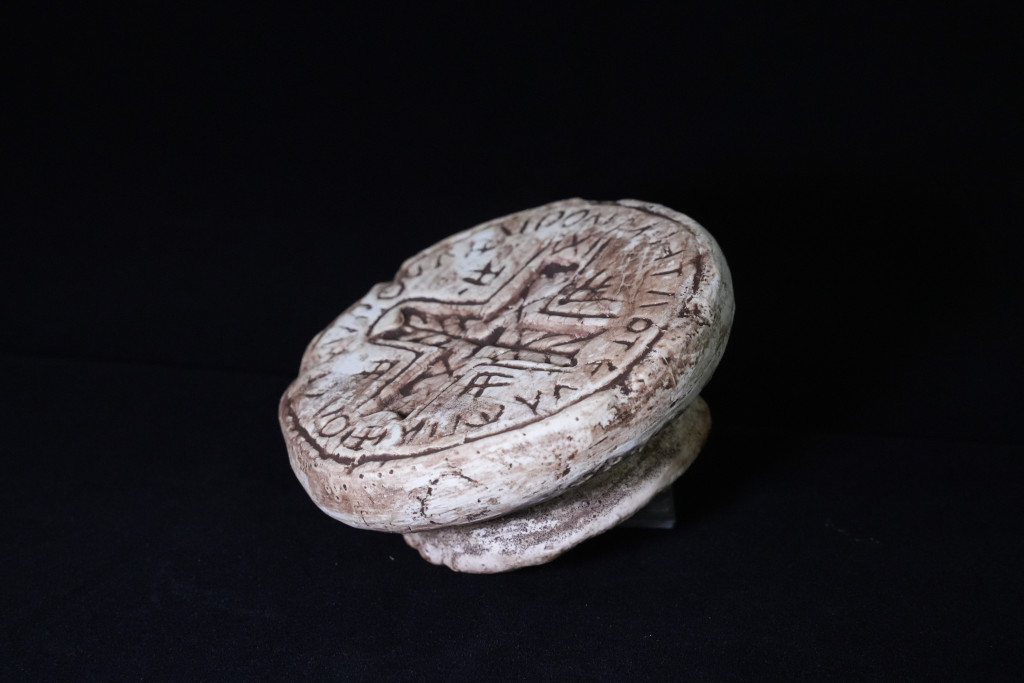
Video of the 3D printing of the Holy bread seal
Final results
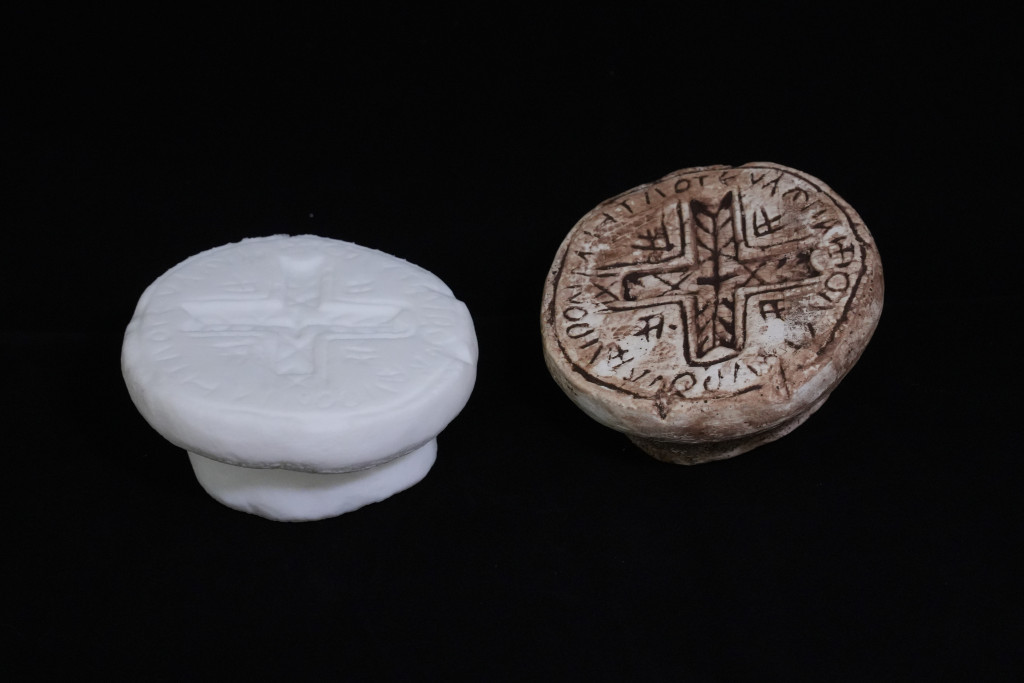

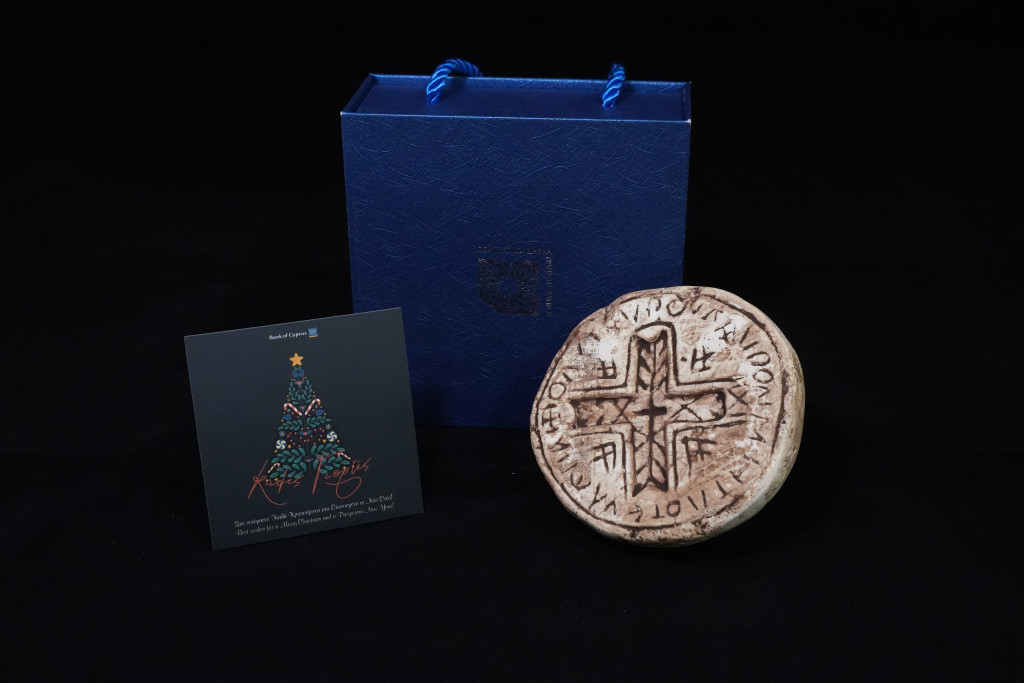
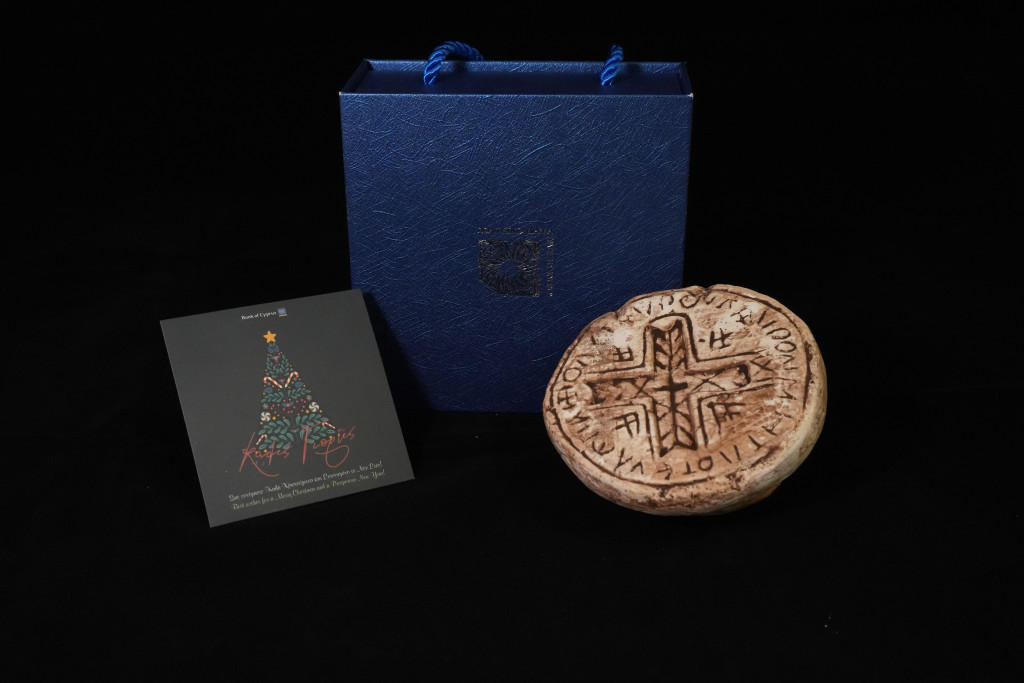
7. Bibliography
- Caseau, B, “Magical Protection and Stamps”, Orientalia Lovaniensia analecta 219 (2012) 115-33, Seals and Sealing Practices in the Near East Developments in Administration and Magic from Prehistory to the Islamic Period, Proceedings of an International Workshop at the Netherlands – Flemish Institute in Cairo on December 2-3, 2009.
- Chronological Table, Department of Antiquities, http://www.mcw.gov.cy/mcw/da/da.nsf/DMLchtable_en/DMLchtable_en?OpenDocument last accessed December 20, 2022.
- Galavaris, George, Bread and the Liturgy. The Symbolism of Early Christian and Byzantine Bread Stamps. The University of Wisconsin Press, Madison, 1970.
- Karagiorgou, Olga, ‘“Nine Seals Worth Ninety”: Sigillographic Finds from Polis Chrysochous, Cyprus’, Studies in Byzantine Sigillography, 12 (2016), 47-69.
- Koltsida-Makre, Ioanna, ‘The Collection of Byzantine Bread Stamps in the Loulis Museum (Aghiou Georgiou Mills), Piraeus, Greece’, Studies in Byzantine Sigillography: Volume 13. Alexandra-Kyriaki Wassiliou-Seibt and Christos Stavrakos eds. Turnhout: Brepols Publishers, 2019, 167-181.
- Marava-Hadjinicolaou, Anna, Saint Mamas, Athens: Centre of Asia Minor Studies, 1995 [in Greek].
- Mentzos A., ‘A Stone Mould for a Eulogia’ in Κοurkοutίdοu-Νίkοlaidοu, E., Papanikola-Bakirtzi, D., Tourta, A. eds. (1996), Museum of Byzantine Culture, Greek Ministry of Culture, 9th Ephorate of Byzantine Antiquities Thessaloniki, Νο. 3, Kapon Editions, ISBN 960-7254-38-4.
- Metcalf, David Michael, Byzantine Lead Seals from Cyprus, Vol. 1 (Texts and Studies of the History of Cyprus) Nicosia: Cyprus Research Centre, 2004.
- Metcalf, David Michael, Byzantine Lead Seals from Cyprus, Vol. 2 (Texts and Studies of the History of Cyprus) Nicosia: Cyprus Research Centre, 2014.
- Mold for a Eulogia (Blessing) Bread, 600s-900s, Byzantium, Palestine, Byzantine period, 7th-10th century, Wood, Diameter: 8.8 x 1.9 cm (3 7/16 x 3/4 in.), https://www.clevelandart.org/art/1951.152#

